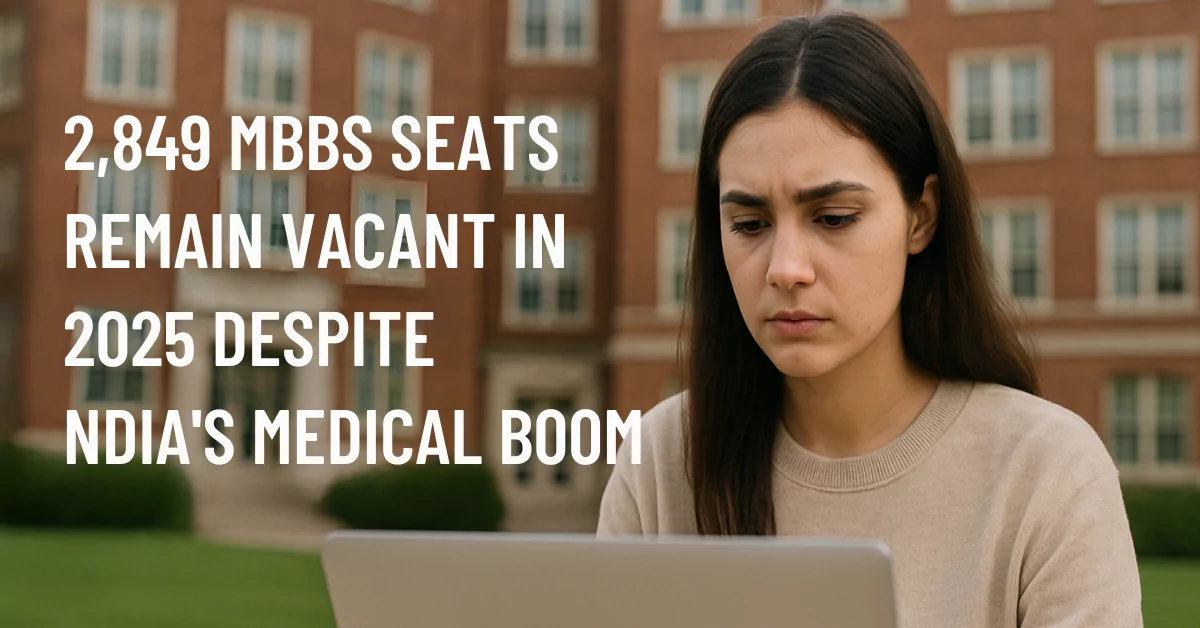New Delhi: Despite India sees 40% growth in medical colleges and 42% rise in MBBS seats over the past five years, thousands of undergraduate medical seats continue to go vacant annually, according to recent data tabled in the Lok Sabha.
On August 1, Minister of State for Health and Family Welfare, Anupriya Patel, presented figures indicating that 2,849 MBBS seats remained vacant in the academic year 2024-25, even as the total number of seats increased to 1,08,900 across India.
This data was in response to an unstarred question raised by Putta Mahesh Kumar, Member of Parliament from the Telugu Desam Party.
Vacant MBBS Seats: A 4-Year Snapshot (Excluding AIIMS & JIPMER)
| Academic Year | Vacant Seats |
|---|---|
| 2021–22 | 2,012 |
| 2022–23 | 4,146 (peak) |
| 2023–24 | 2,959 |
| 2024–25 | 2,849 |
Though the number of vacant seats dropped from the 2022-23 peak, the consistent shortfall highlights systemic issues in seat utilization, especially in private medical colleges.
Expansion in MBBS Seats
India’s medical education revolution and capacity has expanded aggressively in recent years. The number of MBBS seats increased from 83,275 in 2020–21 to 1,08,000 in 2024-25, thanks to new colleges, infrastructure upgrades, and regulatory support.
According to the ministry, this increase was facilitated through centrally sponsored schemes aimed at building new medical colleges and upgrading existing ones, particularly in underserved and aspirational districts.
States with MBBS Seats increase from 2020-21 to 2024-25
| S.No. | State/UT | MBBS Seats (2020–21) | MBBS Seats (2024–25) |
|---|---|---|---|
| 1 | Andaman & Nicobar Islands | 100 | 114 |
| 2 | Andhra Pradesh | 5,210 | 6,585 |
| 3 | Arunachal Pradesh | 50 | 100 |
| 4 | Assam | 1,050 | 1,700 |
| 5 | Bihar | 2,140 | 2,995 |
| 6 | Chandigarh | 150 | 150 |
| 7 | Chhattisgarh | 1,345 | 2,105 |
| 8 | Dadra & Nagar Haveli | 150 | 177 |
| 9 | Delhi | 1,422 | 1,346 |
| 10 | Goa | 180 | 200 |
| 11 | Gujarat | 5,700 | 7,000 |
| 12 | Haryana | 1,660 | 2,185 |
| 13 | Himachal Pradesh | 920 | 920 |
| 14 | Jammu & Kashmir | 1,135 | 1,385 |
| 15 | Jharkhand | 780 | 1,055 |
| 16 | Karnataka | 9,345 | 12,194 |
| 17 | Kerala | 4,105 | 4,705 |
| 18 | Madhya Pradesh | 3,585 | 4,900 |
| 19 | Maharashtra | 9,000 | 11,844 |
| 20 | Manipur | 225 | 525 |
| 21 | Meghalaya | 50 | 150 |
| 22 | Mizoram | 100 | 100 |
| 23 | Nagaland | 0 | 100 |
| 24 | Orissa | 1,950 | 2,675 |
| 25 | Puducherry | 1,530 | 1,873 |
| 26 | Punjab | 1,425 | 1,699 |
| 27 | Rajasthan | 4,200 | 6,279 |
| 28 | Sikkim | 50 | 150 |
| 29 | Tamil Nadu | 8,000 | 12,000 |
| 30 | Telangana | 5,240 | 8,915 |
| 31 | Tripura | 225 | 400 |
| 32 | Uttar Pradesh | 7,428 | 12,325 |
| 33 | Uttarakhand | 825 | 1,350 |
| 34 | West Bengal | 4,000 | 5,699 |
This expansion, however, hasn’t translated into full seat occupancy, with affordability, accessibility, and procedural complexities continuing to hamper enrollment in certain colleges, particularly self-financed private institutions in remote areas.
Government Initiatives for Medical Education Expansion
Centrally Sponsored Scheme for New Medical Colleges:
- 157 medical colleges approved.
- 131 already functional.
- Focus on underserved and aspirational districts.
Infrastructure Strengthening of Existing Colleges:
- Centrally sponsored support to increase UG and PG capacity.
- Targeted at both state and central government colleges.
PMSSY – Super Specialty Blocks:
- 75 super-specialty projects approved.
- 71 completed.
- Objective: Upgrade existing government medical colleges.
AIIMS Expansion:
- 22 new AIIMS approved.
- UG courses commenced in 19 AIIMS institutions as of 2025.
NMC’s Minimum Standard Requirement (MSR) Regulations, 2023:
- Mandate essential norms for infrastructure, faculty, equipment, and clinical material.
- Intended to ensure uniform quality across institutions.
- Meanwhile NMC faculty rules to expand medical education have also been changed.
Why Are MBBS Seats Still Vacant?
Despite the increased capacity, several factors contribute to the under-utilization of MBBS seats:
- High Tuition in Private Colleges: Many private institutions charge upwards of ₹15-30 lakh per year, deterring middle-class NEET qualifiers who miss government seats.
- Last-Minute Dropouts & Counselling Complexity: Late withdrawals, complicated state counselling rules, and document verification issues result in vacant seats.
- Lack of Awareness/Support in Remote Areas: Candidates from rural or backward regions may not have access to effective counselling guidance.
- Disparity in College Reputation: Students often prefer top-ranked colleges, leaving new or lower-ranked institutions with unfilled seats.
Medical education experts say that mere expansion of capacity isn’t enough. “We need parallel reforms in affordability, faculty development, and transparent counselling systems,” says Sanjay Tiwari, a medical education policy analyst. “Otherwise, vacant seats will continue to be a paradox in a country where lakhs of NEET aspirants remain without a medical seat each year,” he added.
Making Seats More Accessible
Sanjay Tiwari emphasised that all states in India should follow Bihar as private MBBS colleges fully implemented 50% Govt-Fee Rule in Bihar.
To make medical education more equitable and to reduce wastage of seats, experts and stakeholders recommend:
- Introducing Fee Caps & Scholarships in private colleges.
- Strictly implement NMC Fee Guidelines.
- Better Coordination Between AIQ & State Counselling to avoid overlapping seat allotments.
- Technology-Driven Counselling Tools to ensure clarity and avoid last-minute dropouts.
- Strengthening Quality Across Institutions so that students don’t avoid colleges due to poor facilities or lack of clinical exposure.
India’s massive expansion in medical education is undoubtedly a significant achievement. But as the 2,849 vacant MBBS seats in 2024-25 reveal, the task is far from over. The focus must now shift from quantity to quality, equity, and utilization to ensure that no seat goes to waste, and no deserving aspirant is left behind.

